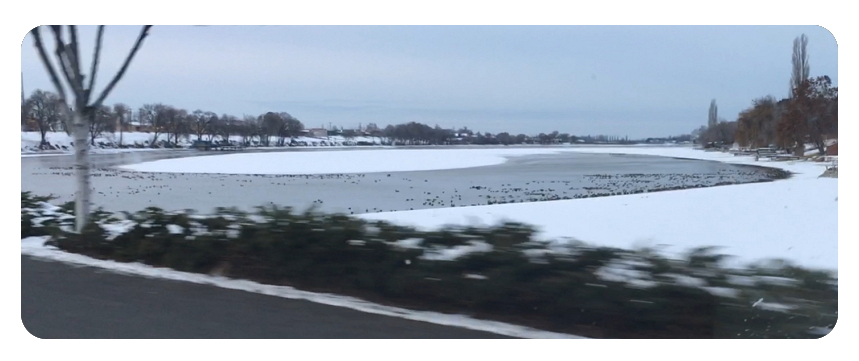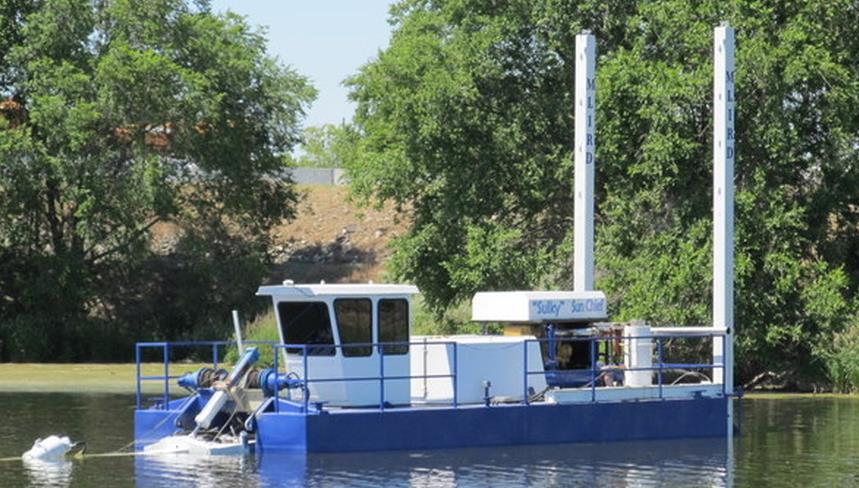

 2019: MLIRD is coordinating a restoration project on the west side (fountain side) of the Alder Street Fill. This project will remove the 'island' which is the result of sediment accumulation over many years coming in from Crab Creek. Kayden Industries will use their hydraulic dredge and booster pump to move an estimated 50,000 cubic yards to an upstream dewatering location where sediment is processed out and relocated as fill-dirt elsewhere. 
Previous Dredging Operations Permit renewal efforts were successful allowing MLIRD to continue dredging upper Parker Horn. Once secured, MLIRD started dredging in July of 2016 as the first year of that renewed permitting process. Our goal in 2016 and 2017 has been to finalize the sediment trap to the extent possible which was defined earlier as an objective for the District. Earlier Board Decisions Set Dredging Operation in MotionSediment has been accumulating and degrading water quality in Moses Lake for a very long time. As more irrigation water, modern farming practices and fertilizer use increased in the Crab Creek and Rocky Ford drainage areas that feed Moses Lake, so too has sedimentation increased. In January of 2003, newly elected Director Richard Teals stated in a Board meeting, “I would like to pursue the possibility of displacement of silt buildup in Moses Lake.” Consultants were hired to formulate a plan for sediment removal but the permits and method of removal proved to be unsuccessful. For the first time since formation of the District, in March of 2007, the Board of Directors consisting of Norm Benson, Glen Rathbone and Richard Teals voted to hire a professional manager to move Moses Lake rehabilitation forward. Today many years later, the District has successfully acquired the necessary permits and the proper equipment for dredging operations that began in Parker Horn on July 1, 2011.
Lake Rehabilitation - Parker Horn DredgingMLIRD and local property owners entered into agreements for permissive use of properties adjacent to Parker Horn which allowed MLIRD to construct sediment ponds for dewatering soil material being dredged from the lake. Dredging began July 1, 2011 and to this day, dredging operations use a suction dredge, currently the only approved method of removing sediment from Moses Lake. Sediment BackgroundCaused by both human and natural processes, excess sediment flowing into Moses Lake has been estimated at 50,000 cubic yards annually. If not managed, impact from sedimentation may affect property values, changes to lake navigation, and fish & wildlife habitats. As silt build-up in the lake began to increase following completion of Grand Coulee Dam in 1942, earlier projects over many years failed to seriously reduce or stop the process. Better research and modern techniques were obviously needed. Begun anew in 2007, the district has now completed a series of comprehensive management plans, acquired and fully restored the dredging equipment necessary to proceed. Dredging starts at Parker Horn, off State Route 17The new to MLIRD, 53,000-pound dredge was lowered into Moses Lake on June 18th, 2011. Starting July 1, the dredge began removing over 60 years worth of sediment buildup from the lake’s bottom. The work started near the Crab Creek inlet to Moses Lake at the Parker Horn location, off state Route 17. The result meant improvements in the lake water quality, fewer weeds, less algae, and improved fishing by providing a better habitat. Placing the dredge in the lake generally goes smoothly with the help of a local crane service and between June and July 1st, district staff install a 10-inch dredge discharge pipe from the dredge to the sediment pond. Soon after July 1st, seasonal dredging begins and continues into November. Weather-wise, once the lake begins to drop and starts icing up, the dredge is removed to avoid equipment damage. Coast & Harbor Engineering initially helped the district select the dredge, an Ellicott 370 HP Dragon model, said Aaron Horine, coastal engineer with the Edmonds-based company. The engineering company was one of the entities involved with the district on the project, in addition to Grette Associates and the City of Moses Lake, he said. The project group at the time, worked closely together to make sure everyone understood the intent and expectations of the project. There are dredges ranging from the district’s dredge, at 57.5 feet in length, to as large as 200 to 300 feet, he explained. The company completed a design of the dredging area, completed modeling for the flow through the bridge and designed a sediment trap, or hole, at the bottom of the lake. Workers remove sediment from the trap, instead of having to follow it down the lake. The main idea with the sediment trap’s design was for it to act as a sump, so materials would fall into the deep hole. There are some people who cannot access docks because of the sediment, he said and estimated district staff could remove 60,000 cubic yards of sediment on that year. An average sized dump truck holds 10 cubic yards of material. Some factors include the production of the dredge and how quickly the material is removed and the District has considered a silt relocation project where a selected bidder may relocate sediment to the District’s Connelly Park location. Until the start of dredging on July 1st Horine said, staff will test-run equipment on the dredge to ensure the equipment is working properly. He worked with the same dredge model for projects in Western Washington and Texas. By Lynne Lynch (columbiabasinherald). Article can also be found at dredgingtoday.com
Officials Explain Plans for Dredging Moses LakePeople involved in a plan to remove sediment from Parker Horn in Moses Lake explained their plans. Representatives from the firms planning the dredging, the Moses Lake Irrigation and Rehabilitation District, the City of Moses Lake and the state met and answered questions during a recent forum at Big Bend Community College. They talked about plans to remove sediment from the lake next to Alder Street. Glenn Grette, a senior biologist and principal with Grette Associates, explained his firm became involved in the project after the district tried for several years to dredge the lake. “The district had been trying for a couple years to permit some dredging action at Parker Horn and elsewhere,” he said. “Those had not been going well through the permitting process. In addition, through some misunderstanding, the district had taken some action and started to dredge … that created a real difficulty between the agencies and the district.” Grette’s firm was hired to examine the sediment problem in the lake and how to manage it and develop a plan to protect the lake, he said. “It was decreasing the open water habitat for fish and wildlife,” Grette said. “There was an environmental component to what was going on. We saw blockages occurring to boating facilities as well as recreational boating areas. Water quality is getting degraded.” The firm’s conclusion was if nothing was done the quality of the lake was going to deteriorate quickly, he said. When the firm examined the lake, it found natural and human sources of sediment coming into it, Grette said. About 85 percent of the water running into Moses Lake comes from the Rocky Coulee Wasteway, 10 percent comes from Rocky Ford Creek and 5 percent from Crab Creek. Grette said the sediment management plan developed for the district addresses eight different areas, and Parker Horn is one of them. “The decision was made to go there first because it was a place where sediments were being (put into) the lake,” he said. “It seemed to make the most sense to hit those areas first to short stop the materials coming into the lake.” He explained the shoal in next to Stratford Road has grown to a point where it has created a channel, which is now carrying sediment past the fill and depositing it on the other side of the fill. “So what we see starting to happen now is a condition that occurs above the crossing starting to develop below the crossing because it can not stop in this portion,” Grette said. Grette and engineer Vladimir Shepsis, of P.E. Coast and Harbor Engineering Inc., Developed a plan to create a trap for the sediment. The plan calls for creating a hole in the bottom of the lake where water will slow and deposit the sediment before it goes into the rest of the lake. Shepsis developed a range of sediment traps which could hold between 30,000 cubic yards and 240,000 cubic yards, Grette said. “You can build that range of sizes of a hold in the mud to trap the other mud as it goes by,” Grette said. “These types of options vary by how frequently you have to dredge them out and, of course, the effort it would take to construct it.” The firm received a permit for the maximum amount of 240,000 cubic yards, he said. The permit gives the district flexibility on how to implement the trap. Shepsis explained the plan calls for dredging part of the shoal off during the first year, then possibly creating a channel on the other side of the shoal, speeding the water past both sides of the shoal. “We said, ‘Instead of chasing these particle sediments all over Moses Lake why don’t we create in one location, a sediment trap – trap the sediment in one location where it’s easy to extract the sediment,” he said. To create the basin, the district plans to use a hydraulic dredge, Shepsis said. The boat is able to remove 140 cubic yards of material an hour and pump it a mile away. The plans call for creating a pond to allow the sediment to settle of the water and return the water back to the ground. Grette said the permit allows the district to dredge, starting July 1 until Nov. 30. The district is also allowed to dredge in March. “Those are just based on trying to keep out of some of the fish and wildlife time periods that are important,” he said. “It’s typical practice for in-water work to have an established time period you can work in and avoid the more sensitive time periods.” Jeff Korth, from the state Department of Fish and Wildlife, said the project’s impact on fish and wildlife in the area will be neutral. “The idea here is to maintain the structure of the lake, more or less the way it is now, improve the channelization of the water through … but maintain fish and wildlife habitat as you see it out there,” he said. When Grette was asked why the district can’t use construction equipment to dig the sediment trap, he said the district tried it in the past. “That’s an interesting question. That’s how I got involved in this project,” he said. “There are a lot of rules as to how you work below the water line and the jurisdictions that are involved, depending on how you do the work.” He said any action including driving equipment onto the shoal creates problems with getting a permit, and brings in federal jurisdiction into the project. By Cameron Probert (columbiabasinherald), Article can also be found at dredgingtoday.com
 |